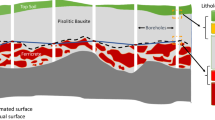Abstract
Traditionally within the mining industry, single models for both grade and geology of orebodies are created upon which all mine development decisions are based. These models provide a single interpretation of the extent and continuity of the mineralization envelope based on solids and sections interpreted from relatively widely spaced drilling. The inherent variable behavior of grade and geology cannot be understood from a single estimated resource model. To account for uncertainty in the geology and mineralization envelope, Newmont Mining Corporation uses multiple-point statistics (MPS), an emerging spatial simulation framework, which can be employed to generate multiple, geologically realistic, realizations of data representing attributes of mineral deposits that display complex non-linear features. MPS uses a conceptual model of the geology, termed a training image, to infer these high-order spatial relationships. A detailed application of the MPS algorithm at the structurally controlled Apensu gold deposit, Ghana, demonstrates the practical intricacies of the MPS framework and documents efficiency and effectiveness. Multiple realizations of the Apensu deposit allow for an assessment of the geologic and volumetric uncertainty, which is further combined with grade simulations to generate a more complete picture of the true uncertainty of the deposit.









Similar content being viewed by others
References
Armstrong A, Galli A, Le Loc’h G, Geffroy G, Eschard R (2003) Plurigaussian simulations in geosciences. Springer, Berlin, Heidelberg, 149 pp
Boucher A (2009) Considering complex training images with search tree partitioning. Comput Geosci 35:1151–1158
Dimitrakopoulos R, Mustapha H, Gloaguen E (2010) High order statistics of spatial random fields: exploring spatial cumulants for modelling complex non-Gaussian and non-linear phenomena. Math Geosci 42:65–99
Duke JH, Hanna PJ (2001) Geological interpretation for resource modelling and estimation. In: Edwards AC (ed) Mineral resource and ore reserve estimation—the AusIMM guide to good practice. The Australasian Institute of Mining and Metallurgy, pp 147–156
Goodfellow R, Consuegra FA, Dimitrakopoulos R, Lloyd T (2012) Quantifying multi-element and volumetric uncertainty, Coleman McCreedy deposit, Ontario, Canada. Comput Geosci 42:71–78
Goovaerts P (1997) Geostatistics for natural resources evaluation. Oxford University Press, New York, 496 pp
Guardiano F, Srivastava M (1993) Multivariate geostatistics: beyond bivariate moments. In: Soares A (ed) Geostatistics Troia 1992, vol 1. Kluwer Academic, Dordrecht, pp 133–144
Jones P, Douglas I, Jewbali A (2011) Modelling combined geological uncertainty in mining using multiple point statistics. In: Deschenes EG, Dimitrakopoulos R, Bouchard J (eds) World gold 2011. Canadian Institute of Mining, Metallurgy and Petroleum, Westmount, pp 759–770
Lantuéjoul C (2002) Geostatistical simulations: models and algorithms. Springer, Berlin, Heidelberg, 270 pp
Liu Y (2006) Using the snesim program for multiple-point statistical simulation. Comput Geosci 32:1544–1563
Lyster SJ (2009) Simulation of geologic phenomena using multiple-point statistics in a Gibbs sampler algorithm. Ph.D. Thesis, University of Alberta, 224 pp
Lyster S, Deutsch CV (2008) MPS simulation in a Gibbs sampler algorithm. In: Ortiz JM, Emery X (eds) Geostats 2008—proceedings of the 8th international geostatistics congress, Gecamin, Santiago, pp 79–88
Mariethoz G, Renard P, Straubhaar J (2010) The direct sampling method to perform multiple point geostatistical simulations. Water Resour Res 469(W11536):1–14
Mustapha H, Dimitrakopoulos R (2010a) A new approach for geological pattern recognition using high order spatial cumulants. Comput Geosci 36:313–334
Mustapha H, Dimitrakopoulos R (2010b) High order stochastic simulation of complex spatially distributed natural phenomena. Math Geosci 42:457–485
Newmont Mining Corporation (2007) Technical Report—Ahafo Gold Project, Brong Ahafo Region, Ghana. Unpublished Company Report. Newmont Mining Corporation
Osterholt V, Dimitrakopoulos R (2007) Simulation of orebody geology with multiple-point geostatistics—application at Yandi channel iron ore deposit, WA and implications for resource uncertainty. In: Dimitrakopoulos R (ed.) Orebody modelling and strategic mine planning, 3rd edn, pp 51–58. Spectrum Series 14
Remy N, Boucher A, Wu J (2009) Applied geostatistics with SGEMS. Cambridge University Press, Cambridge, 264 pp
Robles L, Dimitrakopoulos R (2009) Stochastic simulation of the Fox Kimberlitic Diamond Pipe, Ekate Mine, Northwest Territories, Canada. COSMO Research Report no 3
Straubhaar J, Renard P, Mariethoz G, Froidevaux R, Besson O (2011) An improved parallel multiple point algorithm using a list approach. Math Geosci 43:305–328
Strebelle S (2002) Conditional simulation of complex geological structures using multiple-point statistics. Math Geol 34:1–21
Strebelle S, Cavelius C (2013) Solving speed and memory issues in multiple point statistics simulation program snesim. Math Geosci. doi:10.1007/s11004-013-9489-7
Wu J, Boucher A, Zhang T (2008) A SGeMS code for pattern simulation of continuous and categorical variables: FILTERSIM. Comput Geosci 34:1863–1876
Zhang T, Switzer P, Journel A (2006) Filter-based classification of training image patterns for spatial simulation. Math Geol 38:63–80
Acknowledgements
This paper details ongoing investigations into the application of conditional simulation for risk analysis and would not have been possible without the dedication to innovation by managers and directors at Newmont Mining Corporation. The help of Afia F. Baah, Mining Engineer at Apensu is gratefully acknowledged.
Author information
Authors and Affiliations
Corresponding author
Rights and permissions
About this article
Cite this article
Jones, P., Douglas, I. & Jewbali, A. Modeling Combined Geological and Grade Uncertainty: Application of Multiple-Point Simulation at the Apensu Gold Deposit, Ghana. Math Geosci 45, 949–965 (2013). https://doi.org/10.1007/s11004-013-9500-3
Received:
Accepted:
Published:
Issue Date:
DOI: https://doi.org/10.1007/s11004-013-9500-3




